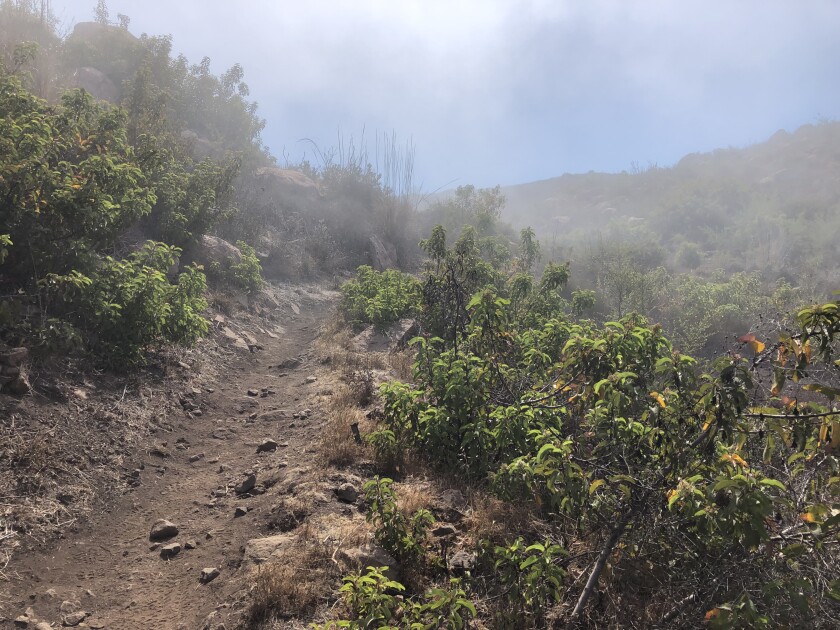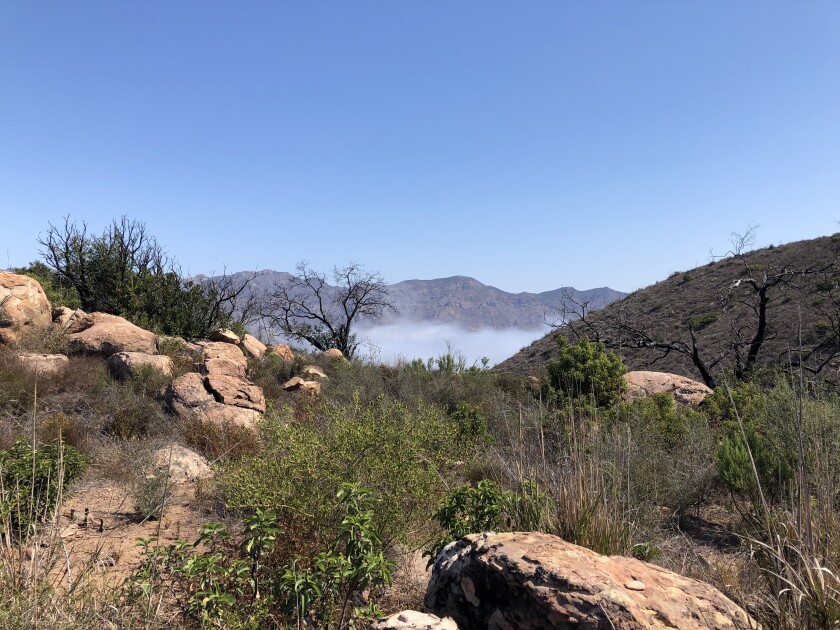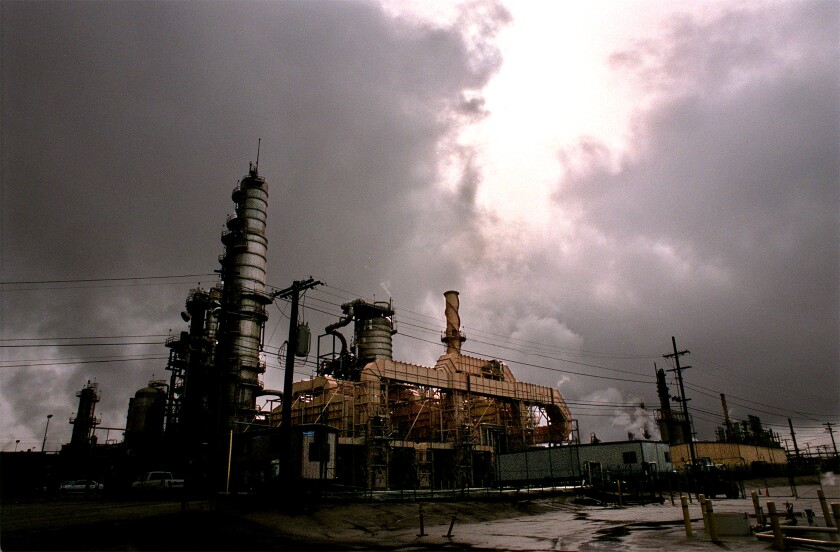This is the July 1, 2021, edition of Boiling Point, a weekly newsletter about climate change and the environment in California and the American West. Sign up here to get it in your inbox.
June has barely come to an end, and parts of California and the West are already suffering through unprecedented heat, punishing drought and rapidly spreading wildfire — a harrowing preview of life on a planet that is only getting more chaotic.
In Vancouver, police responded to 65 sudden deaths over four days as temperatures soared. A town even farther north obliterated Canada’s all-time temperature record with a 121-degree reading, which also would have shattered the record high in Las Vegas.
Portland broke its heat record three days in a row, ultimately reaching 116 degrees. In Seattle, where fewer than half of homes have air conditioning, the mercury hit 108 degrees, also an all-time high. There are at least 80 deaths being reported as potentially heat-related in the Pacific Northwest, and I’d be stunned if that number didn’t grow. Pay close attention to Spokane, in eastern Washington, where thousands of people lost power as the heat forced an electric utility to implement rolling blackouts.
It was so hot that roads buckled in Washington, and a Portland-area transit agency was forced to suspend light-rail service.
Then there are the fires. We’re not yet seeing the kinds of landscape-devouring, sky-turns-orange mega-blazes that made last summer so nightmarish, but we’re already ahead of last year’s pace in terms of acres burned in the West. In Northern California’s Siskiyou County, the lightning-sparked Lava fire forced thousands of people to evacuate and is growing. The Inyo Creek fire closed the Mt. Whitney trailhead, and the Willow fire in Los Padres National Forest, near Big Sur, led to this stunning photograph:
Captain Justin Grunewald of the Mill Creek Hotshots takes a short rest amid his battle against the Willow fire.
(U.S. Forest Service)
The captain pictured is part of a hotshot crew. They’re the country’s most elite firefighting teams, but the federal government has had trouble keeping them staffed because pay is so low and the job is more grueling than ever. President Biden this week boosted firefighter pay to at least $15 an hour, up from as little as $13 today, my colleagues Chris Megerian and Anna M. Phillips report.
You probably don’t need me to tell you that climate change is the underlying condition connecting all these threads. It’s why so many scientists say we must rapidly move toward eliminating emissions from the burning of coal, oil and natural gas.
It’s also why fires, droughts and heat were on my mind as I explored a new analysis from the National Parks Conservation Assn., finding there are more than 31,000 “orphaned” oil and gas wells within 30 miles of national park sites nationwide.
These are wells that are no longer producing and yet haven’t been properly plugged, and whose operators are defunct or can’t be found, and thus can’t be forced to pay for cleanup. As The Times detailed in an investigation last year, California is littered with idle wells at risk of becoming orphaned, and cleaning them up could cost taxpayers billions of dollars. Left unplugged, they can spew planet-warming methane into the atmosphere, expose communities to toxic fumes and contaminate groundwater aquifers.
It’s no huge shock that many of these risky wells are near national park sites, considering how many park units there are — more than 400 overseen by the National Park Service, from name-brand parks such as Yosemite to national monuments, historic sites and scenic trails. Working with FracTracker Alliance, and using state-by-state orphaned-well data, the National Parks Conservation Assn. estimated there are 214,538 orphaned wells across the country, including 31,737 within 30 miles of a national park.
What really caught my eye was the park with the most risky wells nearby: Santa Monica Mountains National Recreation Area. I hike in the Santa Monica Mountains all the time, and I definitely wouldn’t have guessed there are 5,705 orphaned oil and gas wells within 30 miles — nearly twice as many as the park with the next most, Harry S Truman National Historic Site in Missouri.
The Santa Monicas are truly a national treasure, stretching from Point Mugu on the coast to the Hollywood Hills, and offering jutting sandstone cliffs, foggy ocean views and a feeling of immense wilderness just steps from a sprawling metropolis.
“People go to the Santa Monicas to get into nature, to get away from the normal urban ills that we deal with day to day,” said Dennis Arguelles, a senior program manager at the National Parks Conservation Assn. “But to think that so close to the mountains there are all these wells contributing to poor air quality in the region, contributing to climate change — it’s just a stark reminder that … it’s hard to leave behind all the damage we’ve done to the environment over the decades.”
Here are some views from Nicholas Flat Trail, which I hiked two weeks ago:

The fog begins to clear as Nicholas Flat trail ascends from Leo Carrillo State Park into the Santa Monica Mountains in June 2021.
(Sammy Roth / Los Angeles Times)

A view from Nicholas Flat trail in the Santa Monica Mountains.
(Sammy Roth / Los Angeles Times)
National parks advocates worry that abandoned oil and gas wells could pollute air and water within parks and in surrounding towns. They also know that rising global temperatures are already beginning to decimate beloved landscapes, causing ice to melt in Glacier National Park, snowfall to plummet in Yellowstone and Joshua trees to start dying off in the park that bears their name.
The Santa Monica Mountains are no exception. A recent climate change planning document from the National Park Service features a photo of the burn scar from the 2018 Woolsey fire in the Santa Monicas, alongside a warning that, across the country, “it will not be possible to safeguard all park resources, processes, assets, and values in their current form or context over the long term.”
In addition to growing fire risk in the Santa Monicas, global warming could limit the range’s suitability for dozens of bird species and potentially harm plant life, mountain streams and natural ecosystems more broadly, according to the park service.
Here are the 10 national parks with the most orphaned oil and gas wells within 30 miles, per the conservation group’s analysis:
— Santa Monica Mountains National Recreation Area (California): 5,705
— Harry S Truman National Historic Site (Missouri): 2,962
— George Rogers Clark National Historic Park (Indiana): 2,873
— Channel Islands National Park (California): 1,920
— Scotts Bluff National Monument (Nebraska): 1,751
— President William Jefferson Clinton Birthplace Home National Historic Site (Arkansas): 1,588
— Theodore Roosevelt National Park (North Dakota): 1,585
— Mammoth Cave National Park (Kentucky): 1,313
— Fort Scott National Historic Site (Kansas): 1,189
— Big South Fork National River and Recreation Area (Tennessee): 1,187
You can scroll through an interactive map of parks and orphaned wells here. Zooming in on Southern California, it becomes clear why the Santa Monica Mountains top the list. The park is sprawling, and drawing a 30-mile buffer zone around it encompasses the entirety of Los Angeles, as well as the oil fields of Ventura County. If you ever need a reminder that L.A. is an oil town, this is it.
The remains of Southern California’s first commercial oil well, Pico No. 4, were moved from their original location years ago and reconstructed for posterity.
(Glenn Koenig / Los Angeles Times)
America Fitzpatrick, energy program manager at the National Parks Conservation Assn., cautioned that the analysis is based on state-specific data that vary in quality, and that some states probably do a better job tracking abandoned wells than others. It’s also worth keeping in mind that in a place like Southern California, the freeway capital of the world, orphaned oil and gas wells are likely only a small contributor to air pollution and climate emissions.
Still, these abandoned wells are a problem worth tackling — and by some estimations, an economic opportunity.
Researchers from Columbia University and the think tank Resources for the Future found last year that the federal government could create as many as 120,000 jobs through a program to plug half a million orphaned wells, potentially keeping oil and gas workers employed as the fossil fuel industry shrinks. Some estimates of the total number of orphaned wells are much higher.
Colorado Sen. Michael Bennet reintroduced a bill last week that would put $8 billion toward cleaning up orphaned wells over the next decade and require oil and gas companies to set aside more money for cleanup before they’re allowed to drill.
“It’s really unfortunate that the American taxpayer has (had) to address the cleanup that these oil and gas companies should really be responsible for,” Fitzpatrick said. “But we do have this moment where we can provide for the cleanup of these wells, and also reform the system so we’re not continuing to dig ourselves into this hole.”
As for the Santa Monica Mountains, there are only a few orphaned wells within the park’s boundaries, per the interactive map. But in an interesting twist, the proposed Rim of the Valley expansion — which I wrote about last year, and is currently working its way through Congress — would add the site of Southern California’s first commercial oil well, known as Pico No. 4, to the park.
Whether that oil well ultimately serves as a monument to a long-gone era of fossil fuel extraction — or as a cruel reminder of our inability to save ourselves, and our parks, from a grim reality of worsening heat, drought and fire — is yet to be seen.
For now, here’s what else is happening around the West:
TOP STORIES

The Russian River, just north of drought-stricken Lake Mendocino in Ukiah, Calif.
(Brian van der Brug / Los Angeles Times)
Folks along California’s Russian River know climate change is worsening droughts, fires, floods and heat — and they’re determined to find a way to live with it. My colleagues Diana Marcum and Brian van der Brug paddled down the Russian River, producing powerful words and pictures about a region where residents are being asked to cut water use by 20% to 40%, and where as many as 2,300 wineries and farms may have their supplies cut off. It’s just one manifestation of a climate emergency in a state that could once again suffer its worst fire season on record, as The Times’ Faith E. Pinho and Alex Wigglesworth report.
President Biden and a bipartisan group of senators agreed on a nearly $1-trillion infrastructure deal. It includes a bunch of climate-related stuff, including $7.5 billion for electric car chargers, $49 billion for public transit and $55 billion to replace lead pipes and upgrade water systems — investments Biden is eager to highlight, my colleague Eli Stokols reports. But it’s still unclear whether the package will be approved — and even if it is, it’s a far cry from the much larger clean energy plan Biden originally proposed. The fate of ambitious climate action may rest in a separate bill that Democrats hope to pass without Republican votes.
It may be a while before we know whether saltwater intrusion from rising seas contributed to the horrifying Florida building collapse. But the disaster — more than 150 people are feared dead — has residents up and down the Sunshine State’s low-lying Atlantic shoreline nervous about what comes next as the ocean continues to rise, The Times’ Jenny Jarvie reports.
DROUGHT IN THE WEST
“Drought, The Everything Disaster.” So reads the headline of this Brett Walton piece for Circle of Blue, and I’m not sure truer words have ever been written. Drought is drinking water supplies contaminated by sediment flushed out of burned forests after brutal fires. It’s household wells going dry, and an entire town in the San Joaquin Valley going without running water during a heat wave. It’s a plague of voracious grasshoppers, and it’s rattlesnakes slithering into cities — just what we need now that rising temperatures have helped make California a hot spot for disease-carrying mosquitoes, as Times columnist David Lazarus writes.
In a tiny bit of good news, drought also means less polluted beaches in Southern California. My colleague Rosanna Xia wrote about Heal the Bay’s latest beach record card, which found a big reduction in pollution last summer — seemingly because there wasn’t much rain to flush trash, pesticides and bacteria to the ocean through storm drains. Heal the Bay also published its third annual River Report Card, which is a good resource to have on hand if you enjoy fishing, swimming or kayaking in local streams.
The U.S. Supreme Court declined to hear an an appeal filed by Imperial Valley farmer Mike Abatti in a dispute over who controls the largest share of Colorado River water in the American West. The high court’s decision means the publicly owned Imperial Irrigation District will continue to shepherd the region’s 3.1 million acre-feet, the Desert Sun’s Janet Wilson reports. I wrote last year about how the case could affect the 40 million people across seven states who depend on the Colorado.
THE ENERGY TRANSITION
The Chevron oil refinery under storm clouds in El Segundo, Calif.
(Genaro Molina / Los Angeles Times)
Oil companies face growing pressure from investors to do more on climate — but whether they’re responding is another question. L.A. Times columnist Michael Hiltzik wrote about what investors are demanding, noting that 60% of Chevron shareholders voted for the company to “substantially” reduce its greenhouse gas emissions. A few weeks before that, an Exxon Mobil lobbyist acknowledged in a private meeting — which was actually a sting operation by Greenpeace UK — that the company is working to weaken federal climate action despite its public pledges of support, as the New York Times’ Hiroko Tabuchi reports.
Returning to abandoned oil and gas wells, an artificial island off the coast of Ventura County tells the story of how drilling companies can often walk away from huge liabilities. The Desert Sun’s Mark Olalde found that taxpayers have footed millions of dollars in offshore cleanup costs as a result of the island’s operator using bankruptcy to avoid paying the full bill.
California officials are ordering utilities to buy 11,500 megawatts of new clean power. That is a staggering amount, and it’s designed to help replace the Diablo Canyon nuclear reactors and several coastal gas plants, which I wrote about in May. Canary Media’s Jeff St. John notes that the requirement includes 1,000 megawatts of long-duration storage (which will make the Eagle Mountain pumped hydro folks happy) and 1,000 megawatts of 24/7 zero-carbon power (which will make the Imperial County geothermal folks happy). In Oregon, meanwhile, lawmakers passed a bill requiring the state’s major electric utilities to eliminate carbon emissions by 2040 — five years ahead of California’s timeline, as Dirk VanderHart reports for Oregon Public Broadcasting.
Newsletter
Toward a more sustainable California
Get Boiling Point, our newsletter exploring climate change, energy and the environment, and become part of the conversation — and the solution.
Enter email address
Sign Me Up
You may occasionally receive promotional content from the Los Angeles Times.
POLITICAL CLIMATE
Are Republicans in Congress ready to get to work on climate? I’ve seen a bunch of headlines suggesting they are, spurred by the formation of a Conservative Climate Caucus with more than 60 members. But when methane rules largely supported by the oil industry came to a vote this week, exactly 12 House Republicans voted for them, per the AP’s Matthew Daly. And lest anyone get the idea that climate advocates are totally satisfied with the White House, the New York Times’ Hiroko Tabuchi writes that the Biden administration’s defense of the Line 3 pipeline in Minnesota, which is furiously opposed by local tribes, “has disappointed those who had hoped that the U.S. would finally start taking aggressive steps to ward off the worst effects of global warming.”
Of the nearly 60,000 properties that received federal grants to prepare for disasters over the last two-plus decades, just 48 were on tribal lands. That remarkable statistic comes from this investigation by Christopher Flavelle and Kalen Goodluck for the New York Times, who write that Native Americans were originally forced onto some of the country’s most undesirable lands by the federal government, and are now being displaced again, this time by climate change. In another challenge for tribes, my colleague Celina Tebor reports that Native American households are 19 times more likely than white households to lack indoor plumbing.
Toyota sided with President Trump against California in a dispute over fuel efficiency rules — and now it’s the largest corporate donor to Republicans who voted to overturn the election. More details here from Times columnist Michael Hiltzik.
ONE MORE THING
Two things you definitely shouldn’t do:
— Set off illegal fireworks, especially when fire risk is so high. Hayley Smith reports that L.A.’s city attorney, Mike Feuer, is trying to crack down on illegal firework sales. Let’s all make his job easier.
— Chop down Joshua trees without permission. Lila Seidman writes that a Morongo Basin couple has been fined $18,000 for bulldozing and burying 36 Joshua trees to make way for a new house. Joshua trees are currently a candidate for California Endangered Species Act protection, and it’s illegal to cut them down without a permit.
Stay safe, everybody.
We’ll be back in your inbox next week. If you enjoyed this newsletter, please consider forwarding it to your friends and colleagues.




Comments are closed.